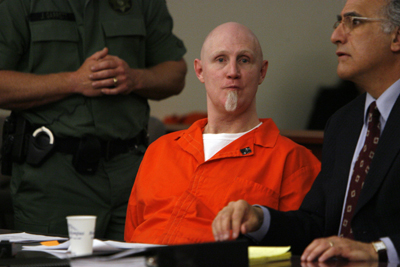
(RNS1-MAY24) Convicted killer Ronnie Lee Gardner has opted to be executed by firing squad, which is reviving talk in some Mormon quarters in Utah about the “blood atonement” that is needed as a payment for sin. For use with RNS-BLOOD-ATONE, transmitted May 24, 2010. Photo by Francisco Kjolseth/The Salt Lake Tribune.
SALT LAKE CITY (RNS) After convicted killer Ronnie Lee Gardner announced his intention to be executed by firing squad, national and international reporters suggested it was a throwback to the wild, wild West.
Some Utahns, though, had a different explanation for why such an anachronistic execution technique remained an option in the 21st century: “blood atonement.”
The term refers to an arcane Mormon belief that a murderer must shed his own blood — literally — to be forgiven by God. Since Mormon pioneers first arrived in 1847, most formal executions (until recent decades) have been by firing squad, which is a lot bloodier than hanging or lethal injection.
When state Rep. Sheryl Allen began proposing eliminating the firing-squad option in the late 1990s, the Church of Jesus Christ of Latter-day Saints itself did not object. Yet talk of blood atonement percolated “in quiet, backroom discussions,” she recalled.
“A couple of people in prominent positions said to me, `We’ve got to have blood atonement.”‘
By 2004, Allen says, all mention of the Mormon concept “just went away” and the measure passed. The LDS Church disavows any connection to blood atonement, says spokesman Scott Trotter.
“We believe in and teach the infinite and all-encompassing atonement of Jesus Christ, which makes forgiveness of sin and salvation possible for all people,” Trotter said.
The firing-squad option soon may be history, yet the mythic appeal of a bloody death as payment for sin persists in some Mormon quarters.
Gardner, who had the option of choosing a firing squad for his scheduled June 18 execution because his original sentencing preceded the law change, told the Deseret News in 1996 he would sue for the right to die that way.
“I guess it’s my Mormon heritage,” he told the paper.
If the LDS Church doesn’t preach blood atonement and the firing squad is virtually finished, why, then, does the notion linger in public and private conversations across the state? The answer may lie in history, symbolism and salvation.
Growing up in Salt Lake City, legal scholar Martin R. Gardner heard older Mormons attribute their support of capital punishment to the idea of blood atonement. As a Mormon missionary in England in the late 1960s, he had a pamphlet, penned by the future Mormon prophet Joseph Fielding Smith, which described and defended the teaching.
“It was always around in the popular consciousness,” Gardner said from the University of Nebraska Law School, where he teaches criminal law.
In a 1979 article in “Dialogue: A Journal of Mormon Thought,” Gardner traced the teaching to Brigham Young, who believed even Christ’s atoning sacrifice for humanity could not cover some sins, including murder, apostasy and egregious sexual misbehavior.
“There are transgressors,” Young said in an 1856 sermon, “who, if they knew themselves, and the only condition upon which they can obtain forgiveness, would beg of their brethren to shed their blood, that the smoke thereof might ascend to God as an offering to appease the wrath that is kindled against them.”
Those sentiments were replayed often by Young and other LDS leaders during the 1850s, “a period of intense Mormon revivalism bordering on fanaticism,” Gardner wrote in “Dialogue.”
Young and others were key players in creating Utah’s first capital-punishment law in 1851, which offered killers the choice of being shot, hanged or beheaded (another blood-shedding option).
In 1888, the Utah Territorial Legislature eliminated beheading but adopted similar language that remained state law until 1980, when lethal injection replaced hanging. The firing squad remained.
(BEGIN OPTIONAL TRIM)
In 1994, attorneys for condemned child-killer James Edward Wood in Pocatello, Idaho, argued that his defense was undermined by a visit from local Mormon leaders who spoke of the need to shed his own blood. Wood, a Mormon, was sentenced to death after pleading guilty to abducting, murdering and then later sexually molesting and dismembering an 11-year-old girl.
In response, top LDS leaders filed a court document denying the doctrine as it has been popularized. The church’s affidavit included a copy of a 1978 letter from LDS apostle Bruce R. McConkie to University of Utah law student Thomas McAfee, outlining the church’s position.
The LDS church supported capital punishment, the apostle wrote, but denied that blood atonement had anything to do with it. “I have never in over 60 years of regular church attendance heard a single sermon on the subject or even a discussion in any church class,” wrote McConkie, who died in 1985.
(END OPTIONAL TRIM)
The symbolism of blood atonement mirrors the Christian story of Jesus’ death on the cross as a ransom for all humanity.
The 19th-century Mormon pioneers added an emphasis on self-sacrifice for sin as a way to appease an angry God, said Levi Peterson, a Mormon novelist and retired English professor at Weber State University. It may have particularly appealed to the settlers, who were coping with a bloody and death-filled era.
Mormon doctrine was “full of promised blessings for the obedient, blessings which were not forthcoming as the Saints were driven from pillar to post,” said Peterson, who now lives in Issaquah, Wash. “An obverse logic took over: The Saints were obviously remiss in their duties; they deserved to suffer; the quickest way back to divine favor was to inflict more suffering on themselves.”
The idea of self-punishing was central to the “guilt I inherited or felt in the people around me,” said Peterson.
“We believed in a severe God who didn’t forgive easily. You had to pay with some kind of pain.”
(Peggy Fletcher Stack writes for The Salt Lake Tribune)




